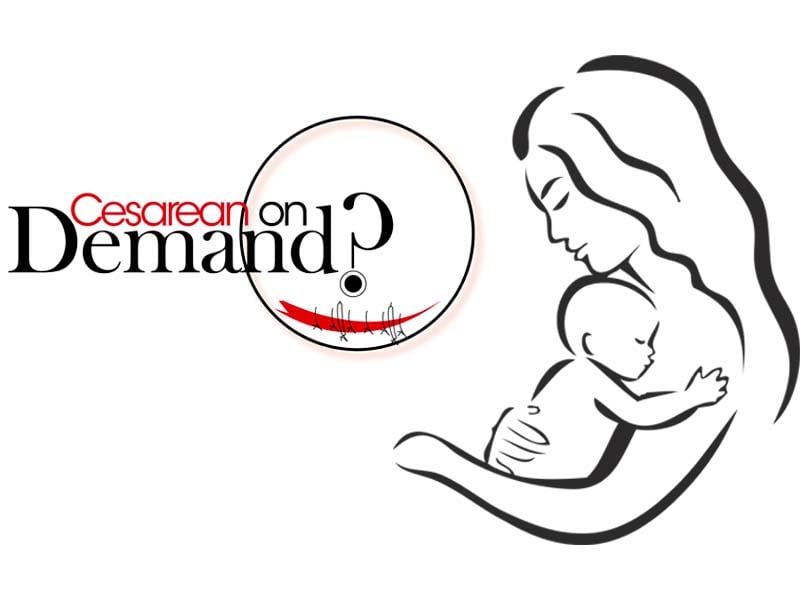
These days, it seems like everyone has had or knows someone who has undergone a C-section during childbirth. According to Women’s Health Magazine, the US witnessed a 60% spike in cesarean delivery rates between 1996 and 2009, alone. More and more women seem to be opting for the surgical procedure without any obvious need for it. But as it turns out, streamlining one’s delivery process prior to time isn’t always a safe bet.
In a nutshell, a C-section involves making an incision in the patient’s abdominal wall so as to retrieve the baby from the uterus. It may sound simple but in reality, the procedure entails many risks and complications which put both the patient and baby at risk. For starters, the laceration made into the expecting mother exposes her to airborne bacteria, which can ultimately lead to infections. There is also a greater chance of excessive bleeding, blood clots and accidental injuries to surrounding organs, such as the bowels or bladder. The recovery period also varies between normal and cesarean births with a maximum of two weeks required for the former. Patients undergoing C-sections, on the other hand, sometimes take up to six weeks to heal satisfactorily.
Although it is rare, some extreme cases of cesarean deliveries can also prove fatal. “The mortality rates have definitely decreased over the years, due to C-sections,” says Dr Nusrat Shah Kamal, a consultant gynecologist at Civil Hospital in Karachi. Her colleague, Dr Nighat Shah, a gynecologist at Aga Khan University Hospital (AKUH) in Karachi agrees and says, “Earlier, there were not enough safety measures but nowadays, if the mother and child are in jeopardy, a C-section is a viable, lifesaving option.”
Many experts believe that basic evolution of the human body has spurred the popularity of cesarean deliveries. “The size of the human brain (head) has increased over the centuries but the female pelvis remains the same,” explains Dr Shah. “If a woman is in the last stages of labour but can’t push, we opt for a C-section.” She also cites domestic purposes, such as immigration processing as encouraging women towards the surgery. “Sometimes, they want their babies delivered within 38 or 39 weeks or by specific dates,” adds Dr Shah.
Nonetheless, both Dr Kamal and Dr Shah suggest that the procedure should only be administered once all other options have been exhausted. For instance, in the case of 29-year-old mother of two Mahnoor Saif*, a C-section was a must. “During my first pregnancy, I didn’t experience any labour pains and other unforeseen complications arose,” shares Mahnoor. “The second time around, my baby wasn’t moving down and it was found that the umbilical cord was wrapped around the neck. Once again, I had to go into surgery.” Dr Shah adds that the majority of deliveries in Pakistan are performed normally and believes, “If a doctor does a C-section without waiting for proper medical indications, it is completely wrong.”

There are a handful of medical conditions doctors will search for to warrant the surgery. A history of infertility, birth defects in the fetus, multiple pregnancies, hypertension, diabetes, previous surgeries, non-progressive labour and a baby in breech (feet/bottoms first) or the transverse (sideways) position, are some of the indications required before an incision is made. Dr Kausar Salam, a senior gynecologist running two birth clinics in Karachi for the past 20 years, shares the example of her patient, 27-year-old Nuzhat Suhail* to highlight the importance of informed judgment and medical indications. “Nuzhat conceived after seven years so taking her into a trial period during labour could have been life-threatening,” recalls Dr Salam. “Not to mention, the child was heavy and Nuzhat herself was very weak.” Fortunately, Nuzhat is now the proud mother of a beautiful baby boy.
Interestingly, cesarean deliveries appear to be more common in public hospitals than private ones, owing to the poor health of the patients that visit them. “Most of the women are anemic, poor or in their seventh or eighth pregnancy,” explains Dr Kamal. “Many a times, they simply aren’t strong enough for a normal delivery and therefore, about 40% to 45% of babies in public hospitals are born surgically.” Despite this, about 80% of births in Pakistan are still performed normally, according to Dr Kamal.
The charges for cesarean deliveries are much higher relative to normal births, with a 50% to 65% increase in fees across Karachi. “Many private hospitals are thriving on money made from unnecessary C-sections, adds Dr Kamal. “The procedure is very profitable as a normal delivery can take up to eight hours or more. The good thing about C-sections is that a doctor can deliver three babies in three hours and so, save time while earning thrice the amount!” She says hospitals ought to charge equally for both types of procedures so as to discourage patients from unwarranted cesarean deliveries.
Dr Salam, however, believes that patients and reputation are much more important than commercial gains. “The notion that C-sections are an option for expecting mothers to consider is completely unethical and incorrect,” says gynecologist Dr Salam. Granted, many expecting mothers ask for cesarean deliveries out of fear of labour pains and the number of those in genuine need of it might be rising but most doctors remain apprehensive of the procedure. “I don’t believe C-sections have become a trend now,” says Dr Shah. “Also, in my experience, rarely do patients actively ask for one.” And in the case where they do, their wishes are answered only due to mitigating circumstances like that of 30-year-old Ruma Tariq*, who lost her first born during a normal delivery. “My first child died shortly after birth, due to some respiratory problems,” shares Ruma. “After that, I was so fearful of losing my second child, I asked for a C-section.” Ruma is now the mother of three children, all of whom were born via surgery.
Regardless of how the baby is delivered, all doctors call for familial support and care during this trying time in a woman’s life. “The most important thing is that the patient should not be left alone at the crucial hour as this will aggravate their fear,” says Dr Kamal. A perfectly healthy, normal delivery should be the aim, through sound time management and support.
*Names have been changed to protect privacy.
Did you know?
You might’ve known all about cesarean deliveries or even undergone one yourself but did you know that April is the designated Cesarean Awareness Month, sponsored by the International Cesarean Awareness Network (ICAN)? A non-profit promoting maternal-child health, ICAN initiated this in order to highlight the increasing number of C-sections being performed in the US and to promote sound medical facilities across the world, through education and support.
Published in The Express Tribune, Ms T, April 26th, 2015.











1736332856-0/Untitled-design-(20)1736332856-0-270x192.webp)



1736334465-0/sidra--(45)1736334465-0-270x192.webp)







COMMENTS (1)
Comments are moderated and generally will be posted if they are on-topic and not abusive.
For more information, please see our Comments FAQ